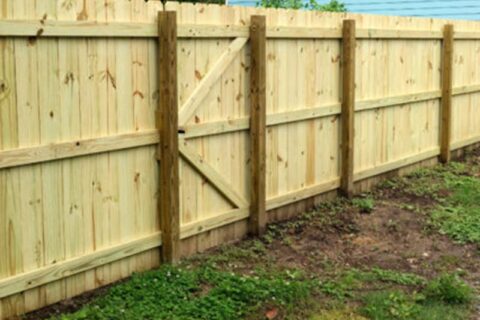7 Tips for Creating a Budget for New Fences
Imagine you’ve just moved into your new home. You’ve paid your deposit and bought some furniture
Then you see the price of new fences. You realize all types of fences can be expensive.
So how do you build your fence without breaking the bank? The answer lies in budgeting your project properly so that it doesn’t cause any financial stress for your household.
Here’s what you need to know about setting a budget for new fences.
1. Check Zoning Codes
The first step in creating a budget for your fence is to check the zoning codes for your area. You may find that fences are allowed in your neighborhood, but there may be height restrictions or other regulations that could affect the type of fencing you choose to install. You might need a permit or fence permit before you can begin building.
With this information in hand, it’s time to get serious about what type of fencing would best suit both your budget and lifestyle needs.
2. Identify Your Needs
Your first step in creating a budget for your fence project is to identify what you need. Perhaps you’re looking for privacy, in which case a privacy fence would suit you.
What are the key elements of your property security? Do you have a dog that’s prone to escaping through an open gate, or do you have kids who like to run off into the field behind their house?
How important is picking a location? Or that your fence be aesthetically pleasing, or will function well enough as long as it doesn’t clash with the color scheme of your home?
These are all questions you need to consider. If you want a three-foot-tall fence because it’s prettier and more stylish than a six-foot-highchain-link barrier, that looks like something out of a prison yard (and who doesn’t?).
But if this will put too much strain on your budget, then maybe those aesthetics should come second—ergo: not necessary for this project after all!
3. Get Multiple Quotes
Get quotes from at least three different companies. It’s a good idea to get an estimate from each company that’s going to be working on your fence so that you can compare them and see which one has the lowest price.
Make sure they’re quoting the same type of fence. You don’t want to get quotes from three companies for different types of fences, then have trouble finding someone who will install it because they don’t do that kind of fencing! This can lead to frustration for both parties involved and result in delays in finishing the project.
Make sure they’re quoting the same type of installation process as well (e.g., DIY vs hiring). A lot of times when we think about how much something costs us, we only look at how much money is spent on materials instead of including labor costs into our budgeting equation—but this isn’t always helpful when deciding between two options with similar material prices.
For example, let’s say Company A offers their customers free delivery service, while Company B charges $50 per visit–when comparing these options alone, there doesn’t seem like much difference between them until you consider labor costs too.
If both companies charge $500 per visit ($300 material + $200 labor) then Company B costs more overall despite having cheaper material prices due solely because its contractors are willing to work longer hours than those employed by competitor A.
4. Consider DIY When Possible
If you’re not a professional, or if hiring a contractor sounds like something that would stress you out, consider taking on the task yourself. It’s not as complicated as it may seem—the best part is that there are tutorials online for just about everything.
The biggest challenge can be finding the right materials at discount prices. Luckily, there are plenty of places to look. Try Craigslist, Freecycle, and then Habitat for Humanity ReStore (or other thrift stores).
5. Pay Cash or Set up a Low-Interest Loan
Pay cash, if you can. However, if you can’t, consider a low-interest loan or a Home Equity Line of Credit (HELOC).
If that doesn’t work, consider borrowing from your 401(k). If you do so, be sure to check into the “borrowing rules” of your plan and make sure they allow non-qualified withdrawals (they usually don’t).
Finally, consider asking family members for help with financing—if they are willing to lend you money at reasonable rates and terms, it may be better than getting an expensive loan yourself.
6. Make a Plan to Stay on Budget
You’ve created a budget, set timeframes, and have a plan to stay on budget. Now it’s time to make sure you follow through on your goals.
Remember that fences are a long-term investment and should not be used for short-term fixes or emergencies. Don’t borrow money to pay for the fence or use credit cards to pay for it.
7. Be Ready to Be Flexible
The great thing about being flexible is that you can use this skill in many areas of life. When you’re trying to keep a budget, it will work just as well for your new fence installation. It’s important to be prepared for things that might cost more than what you originally thought and be ready with an alternate plan if it’s necessary.
You should also know how long things will take so that you don’t hire someone who can’t finish on time because they weren’t expecting something else to come up. Being flexible allows us all to adapt when things change and still feel good about ourselves when the time comes.
Budget for New Fences to Ensure You Don’t End up in Financial Trouble
A fence is a long-term investment. You’ll want to ensure that the fence you choose will add value to your property and give you years of enjoyment. Avoid the drama by setting a budget for new fences instead of taking out a loan.
A good budget for new types of fences involves making sure that every dollar spent on your fencing project will pay off in the long run. This means avoiding expensive materials or labor if it means sacrificing quality, appearance, and safety.
For more info and a free quote on our fence installation services, be sure to contact us today.


